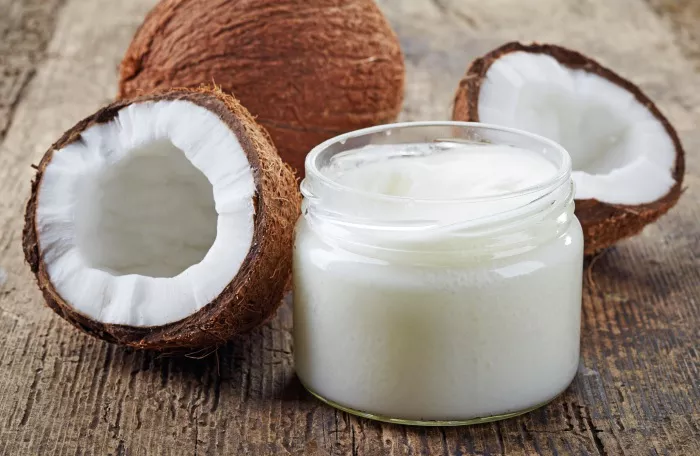Pimple marks, those stubborn reminders of past breakouts, can be a source of frustration for many individuals striving for clear, smooth skin. In the quest for effective remedies, coconut oil has emerged as a popular option, touted for its purported benefits in fading pimple marks and improving skin texture. But is coconut really good for pimple marks? In this article, we’ll delve into the science behind coconut oil, its potential benefits for pimple marks, and important considerations for incorporating it into your skincare routine.
Coconut Oil Composition: Nature’s Nourishing Elixir
Coconut oil is derived from the kernel or meat of mature coconuts harvested from the coconut palm (Cocos nucifera). Rich in fatty acids, vitamins, and antioxidants, coconut oil boasts a unique composition that sets it apart as a skincare ingredient.
One of the key components of coconut oil is lauric acid, a medium-chain fatty acid known for its antimicrobial properties. Lauric acid helps combat acne-causing bacteria, making coconut oil a promising candidate for managing breakouts and preventing new blemishes from forming. Additionally, coconut oil contains capric acid, caprylic acid, and vitamin E, all of which contribute to its moisturizing and skin-nourishing properties.
Research Findings: Separating Fact from Fiction
While anecdotal evidence and personal testimonials abound regarding the efficacy of coconut oil for pimple marks, scientific research on this topic is relatively limited. Studies examining the effects of coconut oil on various skin conditions, including acne and acne scarring, have yielded mixed results.
A review published in the International Journal of Dermatology in 2018 concluded that coconut oil may offer potential benefits for acne-prone skin due to its antimicrobial and anti-inflammatory properties. However, the review also noted the need for further research to fully understand the mechanisms of action and long-term effects of coconut oil on acne and acne scarring.
Another study published in the Journal of Clinical and Aesthetic Dermatology in 2013 found that applying virgin coconut oil to the skin for eight weeks resulted in significant improvements in skin hydration and surface lipid levels. While this study did not specifically focus on pimple marks, its findings suggest that coconut oil may have moisturizing and skin barrier-enhancing effects that could potentially benefit individuals with acne scarring.
It’s important to approach these findings with caution, as the quality and methodology of research studies can vary significantly. Additionally, individual responses to skincare products may vary, and what works well for one person may not yield the same results for another.
Comparison with Other Treatments: Weighing the Options
In addition to coconut oil, several other treatments are commonly used to address pimple marks and acne scarring. These treatments work through different mechanisms of action and may offer varying degrees of effectiveness depending on the severity and type of scarring.
Topical Retinoids: Retinoids are derivatives of vitamin A that help promote cell turnover and collagen production, leading to smoother, more even skin texture. Prescription-strength retinoids like tretinoin or over-the-counter retinol products may be used to fade pimple marks over time.
Chemical Peels: Chemical peels involve the application of a chemical solution to the skin, which exfoliates the outer layer and stimulates collagen production. Various types of peels, such as glycolic acid or salicylic acid peels, can help improve the appearance of pimple marks and acne scarring.
Microneedling: Microneedling, also known as collagen induction therapy, involves the use of a device with fine needles to create controlled micro-injuries in the skin. This stimulates the body’s natural healing response, leading to the formation of new collagen and smoother skin texture.
Laser Therapy: Laser treatments, such as fractional laser resurfacing or intense pulsed light (IPL) therapy, target specific areas of pigmentation or scarring, helping to break up melanin deposits and stimulate collagen production for more even skin tone.
While these treatments may offer effective solutions for pimple marks and acne scarring, they also come with potential drawbacks such as cost, downtime, and the risk of side effects. Coconut oil, by comparison, is often regarded as a more natural and cost-effective option, making it an attractive choice for those seeking gentler alternatives.
Application Methods: Harnessing the Power of Coconut Oil
If you’re considering incorporating coconut oil into your skincare routine to address pimple marks, it’s essential to do so safely and effectively. Here are some tips for using coconut oil for skincare:
Patch Test: Before applying coconut oil to your face, perform a patch test on a small area of skin to check for any adverse reactions or sensitivities.
Choose High-Quality Oil: Opt for virgin
or extra virgin coconut oil, which undergoes minimal processing and retains more of its natural nutrients and antioxidants.
Cleanse the Skin: Start with clean, dry skin before applying coconut oil. Gently cleanse your face with a mild cleanser to remove any dirt, oil, or makeup residue.
Apply Sparingly: Use a small amount of coconut oil and gently massage it into the skin using circular motions. Focus on areas with pimple marks or acne scarring, but avoid applying too much oil, as it may lead to clogged pores or exacerbate acne.
Moisturize: Coconut oil can be used as a standalone moisturizer or layered over your regular moisturizer for added hydration. Allow the oil to absorb fully into the skin before applying any additional skincare products or makeup.
Sun Protection: While coconut oil offers some degree of natural sun protection due to its antioxidant content, it’s essential to use sunscreen with adequate SPF during the daytime, especially when using skincare products that may increase photosensitivity.
Monitor for Reactions: Pay attention to how your skin responds to coconut oil and discontinue use if you experience any irritation, redness, or breakouts. Everyone’s skin is unique, so what works for one person may not work for another.
Potential Risks: Navigating the Downsides
While coconut oil is generally considered safe for topical use, it’s not without its potential risks, particularly for individuals with certain skin types or conditions. Some potential drawbacks of using coconut oil for pimple marks include:
Comedogenicity: Coconut oil has a relatively high comedogenic rating, meaning it has the potential to clog pores and exacerbate acne in some individuals, particularly those with oily or acne-prone skin.
Allergic Reactions: While rare, some people may be allergic to coconut oil or experience sensitivity to its components, leading to symptoms such as itching, redness, or hives. Perform a patch test before using coconut oil on larger areas of skin.
Increased Photosensitivity: Some skincare oils, including coconut oil, may increase the skin’s sensitivity to sunlight, leading to a higher risk of sunburn or sun damage. Use sunscreen with adequate SPF during the daytime when using coconut oil on your skin.
Staining: Coconut oil has the potential to stain clothing or bedding, particularly if applied in large quantities or in combination with other skincare products.
It’s essential to weigh the potential risks and benefits of using coconut oil for pimple marks and acne scarring, and consult with a dermatologist or skincare professional if you have any concerns or pre-existing skin conditions.
Holistic Skincare: Nurturing Your Skin Inside and Out
While coconut oil may offer some benefits for addressing pimple marks and acne scarring, it’s just one piece of the skincare puzzle. Taking a holistic approach to skincare involves nurturing your skin from the inside out, incorporating a balanced diet, adequate hydration, stress management, and healthy lifestyle habits into your routine. Here are some additional tips for promoting overall skin health:
Cleanse Gently: Use a mild, non-abrasive cleanser to remove dirt, oil, and impurities from the skin without stripping away its natural oils.
Hydrate Regularly: Drink plenty of water to keep your skin hydrated from the inside out, and use a moisturizer to lock in moisture and maintain a healthy skin barrier.
Protect from the Sun: Wear sunscreen with broad-spectrum SPF every day, rain or shine, to protect your skin from the harmful effects of UV radiation.
Eat a Balanced Diet: Incorporate nutrient-rich foods like fruits, vegetables, lean proteins, and healthy fats into your diet to support skin health and overall well-being.
Manage Stress: Practice stress-reducing techniques such as meditation, yoga, or deep breathing exercises to help manage stress levels, which can impact skin health.
Get Plenty of Sleep: Aim for 7-9 hours of quality sleep each night to allow your skin time to repair and regenerate.
By adopting a comprehensive approach to skincare and making informed choices about the products and ingredients you use, you can support your skin’s natural healing process and achieve a radiant, healthy complexion.
Conclusion: Navigating the Path to Clearer Skin
In the quest for clear, smooth skin, coconut oil has emerged as a popular natural remedy for addressing pimple marks and acne scarring. With its unique composition and potential benefits for skin health, coconut oil offers a promising option for those seeking gentler alternatives to traditional skincare treatments.
However, it’s essential to approach coconut oil with caution and mindfulness, considering factors such as skin type, individual sensitivities, and potential risks. While scientific research on the effectiveness of coconut oil for pimple marks is limited, anecdotal evidence and personal testimonials suggest that it may offer some degree of improvement for certain individuals.
As with any skincare product or treatment, it’s crucial to listen to your skin, pay attention to how it responds, and make adjustments as needed. Consult with a dermatologist or skincare professional if you have any concerns or questions about using coconut oil for pimple marks, and remember to prioritize holistic skincare practices that support overall skin health and well-being.
Ultimately, achieving clearer, healthier skin is a journey that requires patience, diligence, and a multifaceted approach. By combining the benefits of coconut oil with a balanced skincare routine, healthy lifestyle habits, and professional guidance when needed, you can navigate the path to clearer, more radiant skin with confidence and grace.
[inline_related_posts title=”You Might Be Interested In” title_align=”left” style=”list” number=”6″ align=”none” ids=”6629,6568,6510″ by=”categories” orderby=”rand” order=”DESC” hide_thumb=”no” thumb_right=”no” views=”no” date=”yes” grid_columns=”2″ post_type=”” tax=””]
































